With the onset of summer-adventure season in the Last Frontier, May is Bear Awareness month at Fish Alaska. Many places throughout the state bring fishermen and bears together when in pursuit of river fish. The risk of being attacked by a bear is really quite small, but it happens. From Denali to Seward and on to Haines and Sitka, there were 9 recognized bear attacks last year in Alaska as of October, and there hadn’t been that many since 2008. On average there are roughly 6 reported attacks by bears resulting in injuries each year in Alaska, according to researchers, although the data is speculative. Either way, it pays to be aware of these bear safety measures and how to handle yourself in bear country.
Know How to Act in Bear Country
by Melissa Norris
The best possible thing you can do is to avoid bears. The reality is they are trying to avoid you, too, and since bears are keen at hiding, you have to let them know that you are there by making lots of noise. The most common attacks seem to occur when a bear is surprised by someone’s presence and it is likely to involve a sow with cubs that she innately needs to protect, even if you don’t see the cubs. The evidence points to brown bears being more commonly the attacking bears, versus black bears who are thought to be less aggressive.
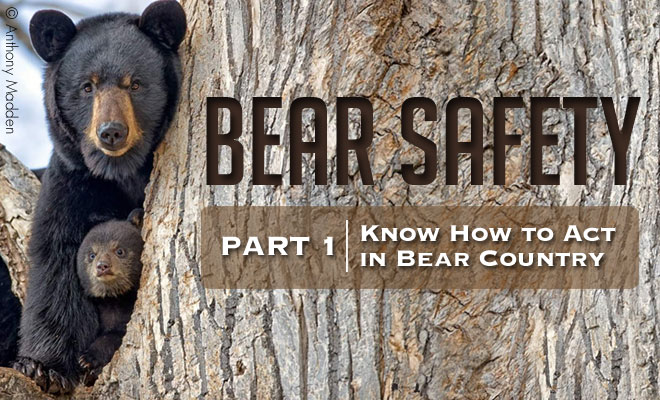
Each human-bear involvement is a unique experience because bears exhibit different behavior. It’s my observation that there is an attitude difference in bears on the Kenai versus bears lumbering the banks of American or Moraine creeks in search of fresh salmon. The bears in Bristol Bay are seemingly more passive, maybe because they have plenty of food and aren’t allowed to be hunted. Be clear, I am not suggesting you bunk down with them like Timothy Treadwell, but I have noticed a difference in how they seem to observe or ignore people. While researching for this Web series I read an article from the Juneau Empire offering bear safety advice from John Hechtel, a retired ADF&G biologist who has extensively studied bears. The article quotes Hechtel as classifying bears either as “defensive” or not and that you handle the situation slightly different for each. You have to let defensive bears know you are not a threat by talking with them calmly in your distinctly human voice and you give them as much space as possible. When encountering bears that are curious or pushy but are not “defensive,” you’ll need to stand your ground.
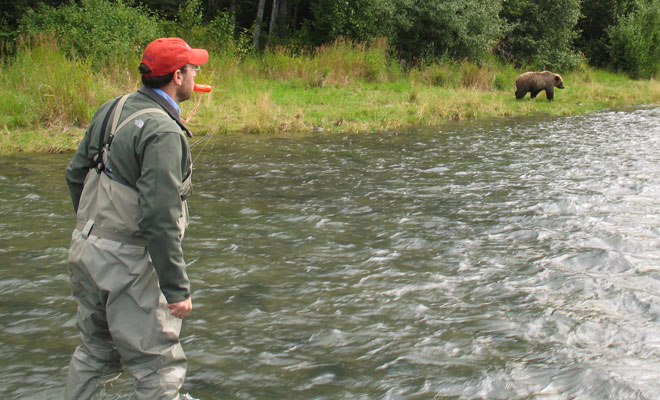
Having a whistle is useful for both alerting your fishing buddies to the bear’s presence and the bear to yours. © Melissa Norris
Fishing in Bear Country
It’s not always simple when you are standing in rapid water up to your waist on the Kenai and a big brownie comes sauntering out of the woods. Maybe even more hair-raising is standing on a remote creek at the top of the Alaska Peninsula after being dropped off by floatplane. It’s you and three other people and you are less than 100 feet from a huge black bear. So if you can’t avoid them, the most important rule is to give bears plenty of personal space. When fishing in both populated and remote areas around bears, heed the following tips:
• Fish with buddies. It is much safer to be in bear country in a group, so buddy-up.
• Upon arrival look for any posted signs about recent bear activity, which are usually posted at trailheads and in campgrounds.
• Make plenty of noise. “Yo, Bear” should definitely be loud and boisterous while you are walking on trails surrounded by thick brush. Wading in the water you should make noise as well. A whistle is handy.
• Be familiar with your surroundings. Have an escape plan if a bear is to come out behind you or across the river. Stop fishing every once in a while to look around.
• Rushing rivers are loud. Have a hand signal worked out with your fishing buddies so you can notify them of any bears approaching.
• Always yield to the bear. Splashing fish sounds the bear dinner bell. If approached by a bear when you have a fish on, cut your line or palm your reel and break the fish off. Don’t give the fish to the bear, teaching them additional bad behavior, but do let the fish go.
• Carry bear spray or an appropriate firearm in an easily accessible location on your body, not in your pack. We’ll review options in a subsequent part of this series.
• Kill fish quickly that you intend to keep. ADF&G recommends you bleed fish right away into the water by ripping or cutting the gills. This improves the quality of the meat and reduces the blood likely to get on the streambank or your waders, which could attract bears. They also recommend you store fish on ice in a bear-proof container. Luckily brands like Yeti, Orion and Igloo coolers have met the Interagency Grizzly Bear Committee’s standards to be called grizzly resistant. The Committee publishes a list of their approved products online. (http://igbconline.org/certified-products-list/).
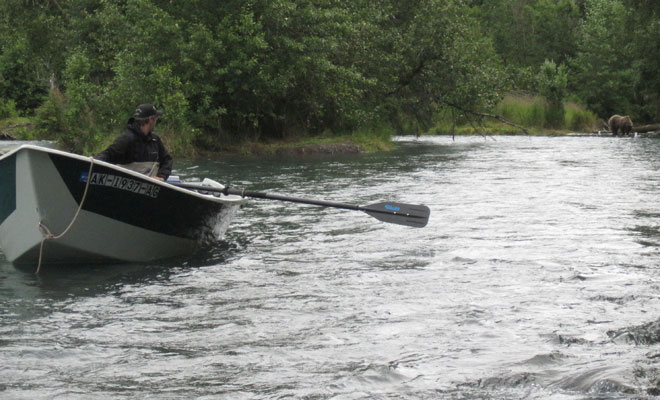
Staying alert in bear country is more than half the battle. © Melissa Norris
Filleting Fish in Bear Country
ADF&G recommends filleting fish at a designated fish-cleaning station or at home. If you are filleting fish riverside, please cut up carcasses into smaller pieces so they can easily be carried down river with the current. Don’t leave fish waste on the riverbank. If you are filleting at home don’t put the waste into the trash until garbage day so it doesn’t attract bears. It can remain in your freezer in a garbage bag until then.
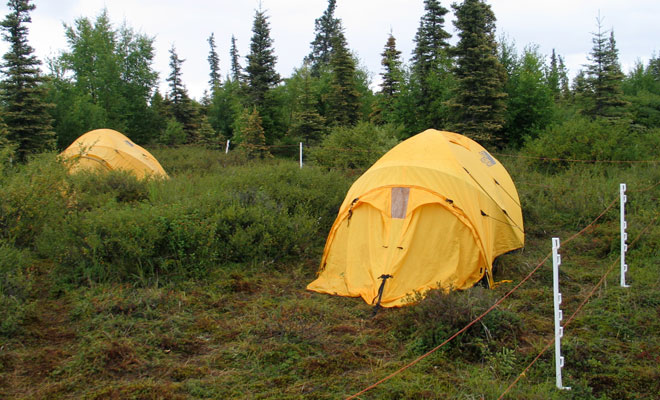
When camping in remote bear country a bear fence helps for peace of mind. © Melissa Norris
Camping in Bear Country
Many folks love to camp under the midnight sun. Keep in mind the following advice while camping in bear country.
• Choose a smart place to camp away from salmon streams, berry patches, trails, carcasses, bear sign and previous camping sites that may retain odors.
• Cook at least 100 feet from your campsite and store your cooking supplies far away from your sleeping area. Clean your dishes at your cooksite because small bits of food will be on pots and pans and dishes.
• Don’t leave trash around. Most campgrounds have a bear-resistant trash receptacle to place your garbage in. If you are remote, consider a bear-resistant container like the Bear Keg from Counter Assault. You could also burn the trash. Experts recommend dumping ashes away from your campsite. Keep your site clean and free of odors that would attract bears.
• Keep food in your vehicle or in a bear-resistant container. You could build a food cache as well with 100 feet of line, plastic bag, a rock and food-storage bag. This is illustrated by the Department of Natural Resources here: http://dnr.alaska.gov/parks/safety/bears.htm.
• Sleep in a tent, not in the open. Keep a flashlight and bear spray in your tent with you in easy reach. Do not sleep in the clothes that you cooked in.
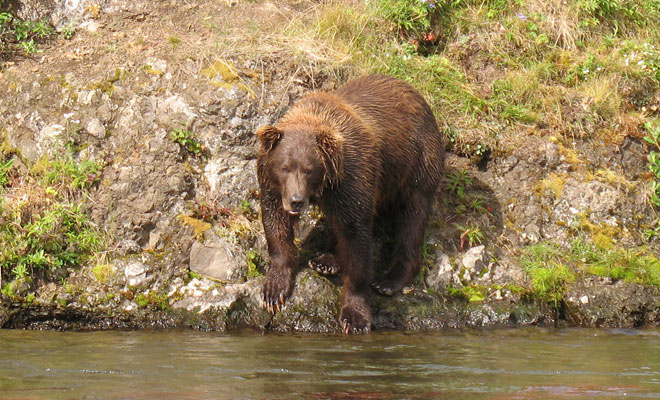
We remember less fishing trips without seeing bears than we do with seeing them so it pays to be familiar with how to act in bear country. © Wayne Norris
Check out more of the Bear Safety Series coming soon, including a Q&A with a bear-safety expert, product reviews on bear sprays and other useful field items for bear safety, and what to do if a bear attack occurs. Remember not to be overly fearful as that will not help you keep your wits about you in an encounter. Your reaction and plan is your strongest defense. The likelihood of anything happening are slim to none, especially when you act responsibly and remain aware of your surroundings.
Bear Safety Part 2: Q&A with Tim Rubbert
Melissa Norris is Publisher of Fish Alaska and Hunt Alaska magazines. If you would like to share your bear safety tips and experience, Melissa can be reached at fishalaska@acsalaska.net.
